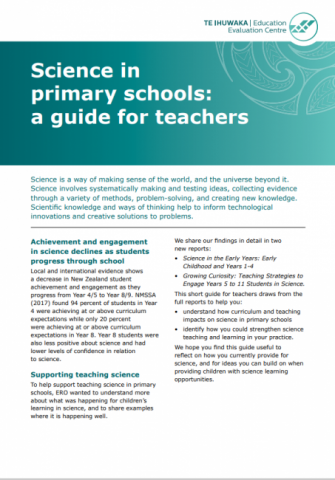Summary
Science is a way of making sense of the world, and the universe beyond it. Science involves systematically making and testing ideas, collecting evidence through a variety of methods, problem-solving, and creating new knowledge. Scientific knowledge and ways of thinking help to inform technological innovations and creative solutions to problems.
Achievement and engagement in science declines as students progress through school
Local and international evidence shows a decrease in New Zealand student achievement and engagement as they progress from Year 4/5 to Year 8/9. NMSSA (2017) found 94 percent of students in Year 4 were achieving at or above curriculum expectations while only 20 percent were achieving at or above curriculum expectations in Year 8. Year 8 students were also less positive about science and had lower levels of confidence in relation to science.
Supporting teaching science
To help support teaching science in primary schools, ERO wanted to understand more about what was happening for children’s learning in science, and to share examples where it is happening well.
We share our findings in detail in two new reports:
- Science in the Early Years: Early Childhood and Years 1-4
- Growing Curiosity: Teaching Strategies to Engage Years 5 to 11 Students in Science.
This short guide for teachers draws from the full reports to help you:
- understand how curriculum and teaching impacts on science in primary schools
- identify how you could strengthen science teaching and learning in your practice.
We hope you find this guide useful to reflect on how you currently provide for science, and for ideas you can build on when providing children with science learning opportunities.
Whole article:
Science in primary schools: a guide for teachersWhat we found impacts on science in primary schools
Intentional teaching gives children opportunities to develop the knowledge, skills and ways of thinking that serve as the foundation for ongoing learning in science
When planning for science, you should think about both the context strands, and the overarching strand; the Nature of Science as well as the Science Capabilities.
A well-rounded science programme involves:
- supporting children to question, predict, critique and try things out
- providing opportunities for students to work with others
- a mix of experiments and research
- deliberately extending students’ science vocabulary
- activities to expand students’ engagement in science for citizenship.
Understanding students’ achievement and progress can help inform decision-making about science
Having good quality assessment information is a key part of informing planning and teaching. You might consider:
- using tools such as the New Zealand Council for Educational Research (NZCER), ‘Thinking with Evidence’ assessment tool to help learn about children’s understanding of scientific concepts
- keeping track of students’ progress, by sharing the specific learning outcomes for a topic or lesson, and asking students to reflect on their progress towards these.
Sharing students’ progress and achievement in science is an important part of developing a learning-focused partnership with parents and whānau.
A responsive science curriculum helps make learning experiences interesting and engaging
Designing science learning opportunities that are meaningful to students is a key way to develop their interest and engagement in science. To do this, you might think about things such as:
- what students already know, and what they are interested in
- the future direction of their learning in science
- the expertise in your community, such as parents, or experts from museums, iwi, local councils, industry and conservation groups
- the local places that could provide interesting contexts for science learning
- the resources, experiences, and experiments students might find interesting.
It is important when doing this, that you consider how well the learning opportunities you have planned support priority learners’ (including students who are Māori, Pacific or have special needs) engagement in science.
Examples of good practice for teaching and learning in science
We share examples of good practice in teaching science on pages 33 and 34 of our report Science in the Early Years: Early Childhood and Years 1-4.
The report, Growing Curiosity: Teaching Strategies to Engage Years 5 to 11 Students in Science, contains the following examples of good practice:
- Engaging students in multiple and rich local learning opportunities, p. 17
- Growing leaderships to improve students’ learning in science, p. 21
- Reviewing and improving students’ engagement in science, p. 25
- Growing curious minds, p. 31
- Improving students’ engagement in and perceptions about science, p.36
- Ensuring all student engage in high quality science programmes, p. 40
- Developing a well-structured curriculum, p. 45
- Scaffolding learning through a spiral curriculum, p. 64
- Raising students’ engagement and achievement in science, p. 67
Where can you go for more help?
Ministry of Education Science hub: Science Online – scienceonline.tki.org.nz
The Science Learning Hub, from the Nation of Curious Minds – www.sciencelearn.org.nz
NZCER: Making progress in science from Levels 1 to 4 – www.nzcer.org.nz/science- progress-workshops
NZCER: Science education publications – www.nzcer.org.nz/research/science- education
If you are teaching science as part of a play-based curriculum, you may also be interested in the examples of good practice in early childhood education shared in our report Shining a light on science: Good Practice in Early Childhood Services.
